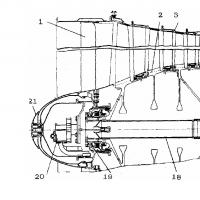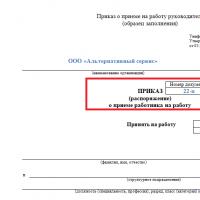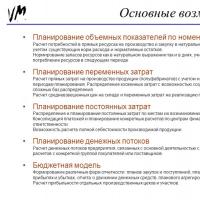What is the theory of six handshakes and why does it work? Does the six handshakes rule work: my email experiment
Malcolm Glaudell, a Canadian journalist and author of books on popular psychology and sociology, calls such people “connectors” and argues that most social connections are made possible through them - people with a very wide circle of acquaintances. Roughly speaking, not every person "A" is connected to every other person "B" through six techniques, but there are several unifiers with a huge amount contacts who, through a small number of handshakes, are connected with each other and with “ordinary” people like the notorious “A” and “B”. By the way, in our age of the Internet, when many have the habit of maintaining acquaintances with casually familiar people through social networks, these chains of handshakes can be even shorter.
Let's return to our assumptions at the beginning of the article. Is meeting the French president a joke? Not really. Another joke about introducing any of us to the Queen of England in five steps arose from Microsoft's analysis of data from more than 240 million users. The number of “handshakes” identified in their study between any “A” and any “B” is 6.6. Another experiment, Facebook, determined this figure to be 4.74.
Australian farmer? Again, no joke. In 2012, Columbia Magazine published an article about a study by Colombian scientists who invited volunteers to find a person anywhere in the world by his name, place of residence and profession using email. During this experiment, an Australian resident “found” the addressee from Siberia after just four messages.
Well, okay, with a peasant from Nicaragua it may not work out so easily. At the end of the day, the number of handshakes, be it four, five or six and a half, is the average number. Nevertheless, the very possibility of such (any!) acquaintance in our “small” world, you see, is exciting.
The world first learned about the theory of six handshakes in the 30s of the last century. It was described in detail in the fantasy story "Links of the Chain" by Friedes Karinthy. The plot was based on an experiment that proved that all the inhabitants of the planet know each other through a maximum of 5 people. This phenomenon became interesting to sociologists, and in 1969 the theory was finally formed. To confirm the hypothesis, American sociologists Jeffrey Travers and Stanley Milgram distributed to residents small town 300 envelopes. The goal was simple: using only your own contacts, deliver a letter to the addressee. 60 letters reached the desired address, and the path length of each letter did not exceed 5 people. The essence of the experiment was as follows: if the subject did not know the addressee, then it was necessary to send a letter to a person who most likely knew him. Perhaps the organizers did not take into account the cost of stamps, so out of 300 letters only 60 arrived.
Later, the experiment was repeated, but using modern means of communication. A total of 20 secret addresses were created, and volunteers were asked to find these people. Surprisingly, the first to succeed was an Australian resident, who found the right address through just four friends. And this address turned out to be not on the next street or even in the next city, but in Siberia!
Microsoft approached the experiment on a grand scale
Microsoft deployed all the necessary resources and spent 2 years, during which specialists analyzed almost 250 million messages and identified relationships. Yes, and again everything came together - any user of the service could find another through 6.6 people on average.
But even knowing about this theory, we are still surprised when we find mutual acquaintances even where it would seem that this is excluded.
Social media experiment
With the advent of the era of social networks, the experiment was repeated in them. Probably, each of us has noticed that when accepting a friend invitation from a stranger, we see one or two mutual friends. Surprisingly, these people tied you up for a long time in real or virtual life, and in fact, you knew each other long before you started communicating on social networks. Facebook, being today the widest social network popular all over the world, conducted its research in collaboration with the University of Milan. And their verdict: the number of links in the human chain is only 4.4. Of course, there is an error, since the registration coverage on Facebook is not 100%.
Arguments in favor of refuting the hypothesis
There are always those who support and those who doubt. Not everyone is ready to accept the theory of six handshakes as an axiom. And the main argument in favor of a refutation was that the chain was interrupted, and not every letter found its addressee. Here you need to take into account human factor: someone did not want to take part, someone forgot or for other reasons refused to take the baton.
As for social networks, in some ways the critics are right: yes, we don’t know all our friends personally, but the Internet allows people to become closer to each other, make virtual acquaintances and communicate without restrictions. You still know each other, albeit in absentia. There are no other, more compelling arguments in favor of refuting the theory.
The VKontakte game as a way to test the theory
You don't even need to install additional applications, just enter any first and last name into the search. From the list provided by the social network, select a person from another city and start playing. Go to his friends list, then go to the page of the first friend on the list and repeat the action. The social network ranks friends by rating, putting the most likely acquaintances at the top. On average, the chain will consist of 3-5 people. Thus, even skeptics can test the theory without leaving home or even leaving their desk. Instructions:
- Choose a “victim” (it must be real).
- Visit her page.
- Go to the page of her first friend on the list.
Theory doesn't always work
Even today there is closed groups who live separately and try to minimize contact with the outside world. In addition, some countries still use a caste system, which has very strict boundaries. And even the Internet cannot shorten this chain between people. In fact, the world of a particular person is determined by his peculiarities of life: habits, place of study and work, favorite places to relax, and it is in this layer that it is quite possible to find acquaintances within 6 handshakes.
What prevents you from confirming or disproving the rule:
- usage different ways communications, messengers and social networks;
- the presence of “closed” groups of people on the planet;
- the impossibility of conducting an experiment involving all the inhabitants of the Earth.
We must take for granted the fact that our world is not monolithic or homogeneous and consists of many layers, in each of which people live according to their own rules. Of course, with the advent of technology, people have become closer to each other, but to fully confirm or refute the theory, 100% participation of all inhabitants of the planet is needed. But this does not seem possible.
The theory of six handshakes in art and cinema:
- play "Six Degrees of Separation";
- movie " Real love»;
- TV series "Friends"
- series "Six";
- movie "Christmas Trees".
- Game "six steps to..."
Movie fans are well aware of the game “Six Steps to Kevin Bacon.” The goal of the game is to find a chain from any actor to Kevin Bacon using the principle “they starred together.” Kevin himself gave the idea for this game, saying that everyone who starred with him starred with all the actors in Hollywood. And mathematicians have a similar entertainment - the game “Erdős Number”. You need to get to Erdős using the principle of “who worked with him.” You can make this dating card yourself and try to play it. At least this interesting idea for an evening with a large group of friends.
Even if the theory is not true, it shows how many potential friends and acquaintances we have in different parts of the planet. After all, if you continue your research further, it is quite possible that you will have not only common acquaintances, but also common interests, hobbies, professional or other preferences. You just need to reach out to find new friends.
Surely many have heard about the theory of six handshakes. Some even call it a “rule”, however, they quite correctly believe that the scheme really works. The essence of the theory is that any two people are connected by no more than six “handshakes.” It's just like in Breaking Bad: a lawyer knows a guy who knows a guy who knows the right guy.
Life in its many manifestations has already proven that the theory works. Therefore, there is no point in confirming it again. In this material I would like to demonstrate how close we are to each other! It turns out, so much so that sometimes two handshakes are enough to contact the person you are looking for on another continent!
A little history...
 The theory of six handshakes was formulated back in 1969 by American psychologists Stanley Milgram and Jeffrey Travers. Their hypothesis was about five levels of mutual acquaintances, but today we know this theory as the implementation of these levels in the form of six “handshakes.” By which we understand, obviously, any information connection: a request, a request and, in general, anything to get “access” to the desired link in the chain.
The theory of six handshakes was formulated back in 1969 by American psychologists Stanley Milgram and Jeffrey Travers. Their hypothesis was about five levels of mutual acquaintances, but today we know this theory as the implementation of these levels in the form of six “handshakes.” By which we understand, obviously, any information connection: a request, a request and, in general, anything to get “access” to the desired link in the chain.
In their results, the researchers based their results on the data of an experiment in which, out of 300 envelopes distributed to participants, 60 reached unfamiliar recipients in another city. Moreover, each envelope that reached its goal passed through five people. Therefore, the theory was called “six handshakes.” But it is obvious that in modern world number of mutual acquaintances up to the right person may be significantly less. Especially in connection with our private and public nature in social networks.
...theories
With the advent of social networks, by the way, a new round of research into the interconnectedness of people in the world has become possible. In 2011, scientists at the University of Milan conducted a study using Facebook and found that network users were separated from each other by an average of 4.74 connection levels. That is, the theory of six handshakes was not only proven mathematically (thus becoming a rule, at least for Facebook), but also showed that it takes a little less than 6 handshakes to connect two people on the planet.

...and practice
Another fun fact is that people searches on social media tend to be set up to show people closest to us. We are talking, for example, about showing the friends of a randomly selected user: among the first to be shown will be the people with whom you personally know the most. This algorithm has brought to life a new entertainment that allows you to see in practice the rule of six handshakes in action. Surely many of you have already heard about this “game”, for the rest I will list the necessary steps.
1. Search for any person who is not your friend. The first and last name can be arbitrary. You can also click on the avatar of any random user. Or choose the candidate you like using a filter by city or country.
2. Go to the list of friends of the selected “victim”. Mutual friends between you and this person may already appear at this stage, in which case the number of handshakes between you is equal to one through any mutual acquaintance. If this does not happen, go to the page of the first (topmost) friend on the list.
3. Go to the first friend's page each time until you see mutual friends. As a rule, this will happen much faster than after five clicks on friends of friends. Just count the number of steps, and exactly that many “handshakes” separate you from the originally chosen person.
You will probably be amazed at how quickly mutual acquaintances will appear between you and a random social network user from Vladivostok, or Yekaterinburg, or Switzerland, or Australia - it doesn’t matter! Having learned about this “game”, I became so accustomed to the “quick” results that I became fed up after a few “games”. Until, finally, I realized that I needed to look for mutual acquaintances not for unknown, random people, but for celebrities! So I decided to count how many handshakes separate me from Putin!
Medvedev+1
 Yes, at least one handshake from
Yes, at least one handshake from
And Geoffrey Travers ( Jeffrey Travers). The hypothesis they proposed was that each person indirectly knows every other inhabitant of the planet through a chain of mutual acquaintances, on average consisting of five people.
By the way, based on the “small world” theory, many popular games in the USA arose. For example, scientists play “Erdős Number”. Hungarian mathematician Paul Erdős is one of the major scientists of the 20th century, with a huge number of co-authored works. We need to find the shortest chain from him to another famous scientist. If he wrote some work together with Erdős, then his Erdős number is equal to one. If co-authored with someone who, in turn, wrote something with Paul Erdős, then this number is equal to two, etc. Almost all Nobel laureates have small Erdős numbers.
IN social network The VKontakte application (“Chain of Friends - Theory of Six Handshakes”) allows you to search for dating chains between network users. Since the VKontakte audience is limited (Russia and CIS countries), it is not possible to achieve the same results as described above - the chains turn out to be shorter (3-4 people). However, it is interesting that chains longer than 6 people are practically never found, which indirectly confirms the original theory.
Perhaps the rule of “six handshakes” appeared in 1929 in the story “Links of the Chain” by the Hungarian science fiction writer Frides Karinthy. Here it was proposed to experimentally prove “that the inhabitants of the Earth are now much closer to each other than ever before.” It was necessary to choose any person from the 1.5 billion (at that time) inhabitants of the Earth, and he, using no more than five people, each of whom was a personal acquaintance of the other, must contact any other person on Earth.
The theory is also illustrated in the films “Love Actually” (2003), “Yolki” (2010), as well as in the TV series “Friends” (season 3, episode 16).
Also, the theory of six handshakes was mentioned in the anime: The Mysterious Library of Dantalian / Dantalian no Shoka, in episode 03 - Book of Wisdom at the 15th minute.
Notes
Links
Wikimedia Foundation.
2010.
See what the “Theory of Six Handshakes” is in other dictionaries:
The theory of six handshakes is a theory according to which any two people on Earth are separated by only six levels of mutual acquaintances. The theory was put forward in 1969 by psychologists Stanley Milgram and Jeffrey Travers. See also... ... Wikipedia
The Small world experiment is a series of experiments conducted in the United States by American sociologist Milgram Stanley in 1967. The purpose of the experiment is to search and analyze the average length... ... Wikipedia
- “4isla” (eng. Numb3rs) detective television series created by Nicholas Falacci and Cheryl Houghton. The television series premiered on January 23, 2005; on May 18, 2010, CBS canceled the series... Wikipedia
Stanley Milgram English Stanley Milgram Birth name: Stanley Milgram Occupation: Social psychologist ... Wikipedia
Genre Comedy Director... Wikipedia
- (English Erdős number) a humorous method for determining the shortest path from any scientist to the Hungarian mathematician Paul Erdős based on joint scientific publications. Erdős wrote 1,475 articles during his life, and many of these works were... ... Wikipedia
The Six Handshakes Theory It's a small world is a practical experiment conducted by Stanley Milgram to find out the average social media path length for people living in America. During the experiment, it was possible to find out that any two ... Wikipedia
Wikipedia has articles about other people with this surname, see Perkins. Oz Perkins Oz Perkins ... Wikipedia
Milgram, Stanley Stanley Milgram (English: Stanley Milgram; August 15, 1933, New York December 20, 1984, New York) American social psychologist, known for his experiment in obedience to authority and his study of the phenomenon ... ... Wikipedia
Books
- The Six Handshakes Theory, Craig Brown. Do you know the theory of “six handshakes”? It states that every person knows every other inhabitant of the planet through a chain of mutual acquaintances, on average consisting of six handshakes.…
IN modern society There are few people who are not familiar with the theory of 6 handshakes. Now that the Internet has erased all boundaries in communication between people who otherwise might never have met, this theory can be renamed the 6-click rule. However, few people know that it was described long before its appearance in the novel of the famous Hungarian writer Frides Karinthy. The work belonged to the genre of fiction and was published when no one had even thought about the theory of 6 handshakes and its essence.
Theory of 6 handshakes
It is difficult to argue with the statement that the world is a small place. Few people have not encountered a situation where, while in an unfamiliar society, they met mutual acquaintances. No one thinks that, in fact, human society is not infinite, it is limited by certain boundaries and, to some extent, closed. In theory, each of us can know any person on the globe through mutual friends or relatives.
It would seem that this is impossible. However, one should not rush to conclusions. There is a theory of 6 handshakes, which is that all people on planet Earth know each other through 5 people, which amounts to 6 levels of communication.
It's a small world
Despite the fact that this theory looks fantastic at first glance, it has existed for quite a long time and has been confirmed more than once.
It is difficult to say when the expression “It’s a small world” appeared. Most likely, it dates back to the times when people lived only on their own territory and practically did not travel beyond its borders.  Over the years, the borders expanded, people began to first visit each other, and then move from their homes in search of a better life. However, in new places we met either fellow countrymen or other people with whom we had once known. As a last resort, in conversations with new people there were almost always mutual acquaintances. It is since then that this concept has entered our lexicon.
Over the years, the borders expanded, people began to first visit each other, and then move from their homes in search of a better life. However, in new places we met either fellow countrymen or other people with whom we had once known. As a last resort, in conversations with new people there were almost always mutual acquaintances. It is since then that this concept has entered our lexicon.
Milgram experiment
The rule about the close ties of humanity is associated with the names of American psychologists Stanley Milgram and Jeffrey Travers, who in 1969 proposed a concept that has come down to us as the theory of 6 handshakes. Even 2 years before the results of the experiment were published, Milgram conducted a study whose purpose was to determine the length of the chain connecting people with each other. Calling it “It’s a Small World,” the scientist developed a special algorithm designed to count the number of connections between two people.
Progress of the experiment
The sites where Milgram's experiment was conducted were the cities of Omaha and Wichita, which are located in the states of Nebraska and Kansas, respectively. The recipient was a resident of Boston. The scientists explained their choice by the fact that, despite the small distance of the cities from each other in terms of geography, their residents were separated by a whole gulf in terms of living standards and education. 
The experiment consisted of randomly selected residents of Omaha and Wichita being sent letters inviting them to take part in a scientific experiment. If they agreed, they should write their details on the form included in the letter. This letter would then be sent to the Boston resident whose name was on the envelope. If the addressee knew him personally, he should have forwarded the letter to him, and if not, then he should have sent the message to a person who was more likely to know him. The only condition was that the envelope should be sent only to a personally acquainted person or relative.
Results of the experiment
The main difficulty of the study was the number of people who agreed to pass on the letter. Moreover, the failure occurred at various stages of the experiment. As a result, out of 296 letters sent with an invitation to participate, the final addressee received 64. At the same time, the length of the chain of friends was on average 5-6 people.  It is noteworthy that many people, when choosing the next addressee, proceeded from the one who lives closer to the addressee’s city, and it was precisely in this case that the letter did not reach its final destination. It took 2 years for the law of six handshakes to be formulated, which with the advent of the Internet received a new meaning.
It is noteworthy that many people, when choosing the next addressee, proceeded from the one who lives closer to the addressee’s city, and it was precisely in this case that the letter did not reach its final destination. It took 2 years for the law of six handshakes to be formulated, which with the advent of the Internet received a new meaning.
6 emails
Already on modern stage development of society, scientists decided to repeat Milgram's experiment using new technologies. A group of Columbia University employees sent 24613 emails to different parts of the planet. The point of the study was that people who received these letters had to find one of 20 recipients. Data about them was minimal: first name, last name, education, occupation, place of residence.  The first success of the study came from a volunteer from Australia, who managed to find his secret addressee in Siberia through just 4 messages. Thus, the theory of 6 handshakes was confirmed for the second time, how to test which many sociologists were interested.
The first success of the study came from a volunteer from Australia, who managed to find his secret addressee in Siberia through just 4 messages. Thus, the theory of 6 handshakes was confirmed for the second time, how to test which many sociologists were interested.
Confirmation of the theory of 6 handshakes on social networks
In 2011, the most famous social network Facebook decided to test the rule of six handshakes. Another study was conducted jointly with the University of Milan. According to its results, the number of links in the human chain is even less than 6 and averages 4.74. Thus, an inhabitant of the planet living on one point of the globe is connected with an inhabitant of another point through “friends of friends.” The only condition is registration in the global virtual community.
The following study of the validity of the theory was conducted among users of the Russian social network VKontakte. Here the chain of friends averaged 3-4 people. Surprisingly, not a single exceeding of the number 6 in the human chain was recorded. Considering the territorial limitation of this virtual community, it can be argued that the results of the study also confirm the theory of 6 handshakes.
Criticism of the 6 handshakes law
Like any research, this rule has been criticized more than once, both by scientists and ordinary people. The main argument that the category of doubters referred to was that the links of the human chain were interrupted more than once in all experiments. However, in this case, the failure of the study occurred only due to the refusal of the participants to pass the baton.
 Another argument critics make concerns social media research. In this case, the object of doubt is the classification of all people on the list of participants’ friends as acquaintances. This is a rather controversial statement, but still, if someone is among your friends on your page on any social network, it means that you still have some kind of relationship with each other.
Another argument critics make concerns social media research. In this case, the object of doubt is the classification of all people on the list of participants’ friends as acquaintances. This is a rather controversial statement, but still, if someone is among your friends on your page on any social network, it means that you still have some kind of relationship with each other.
Thus, the arguments of critics who speak out against the law of 6 handshakes are not weighty enough to provide a serious refutation of the theory.
Truth or Myth
Whether or not to believe the law of 6 handshakes, everyone decides for themselves. However, it is worth considering that in the scientific world they take it more than seriously. Moreover, scientists who speak out for this theory work in a variety of fields, often far from sociology, with which it all began. One of the most striking examples of this attitude of the scientific world is the game “Erdos Number”, named after the Hungarian mathematician who wrote many scientific works. The point of the game is to find the shortest human chain that leads from any randomly selected scientist to Erdős himself. For example, a scientist is assigned the first number if he worked with the founder of the game at any time. The second number is given to the scientist who worked with a scientist who, in turn, worked with Erdős himself. It is noteworthy that most Nobel Prize winners have small numbers in this game.
 By the way, anyone can test this theory, and you don’t need to be a scientist to do this. All you need to do is create your own “dating map”. It is advisable that the link no lower than the fourth should be an acquaintance with a celebrity. The greater his popularity, the higher the likelihood of meeting a huge number of people, including high-ranking people, who, in turn, have no less acquaintances.
By the way, anyone can test this theory, and you don’t need to be a scientist to do this. All you need to do is create your own “dating map”. It is advisable that the link no lower than the fourth should be an acquaintance with a celebrity. The greater his popularity, the higher the likelihood of meeting a huge number of people, including high-ranking people, who, in turn, have no less acquaintances.
So maybe we all know each other after 6 handshakes. Due to a detailed study of all the results of experiments carried out at different periods of time and using different methods, the popular joke about meeting the Queen of England no longer seems fantastic. Think about which celebrity, who until now seemed completely unattainable, you might be familiar with, according to this theory. It is likely that the result of your own research will greatly surprise you.
 Purpose: basic technical data of the AL 31F engine
Purpose: basic technical data of the AL 31F engine What is severance pay?
What is severance pay? How to number the decisions of the sole founder of an LLC?
How to number the decisions of the sole founder of an LLC? How to fill out a vacation schedule?
How to fill out a vacation schedule? Traffic light concepts, history, purpose Food discounter traffic light
Traffic light concepts, history, purpose Food discounter traffic light Order for the appointment of the General Director: sample filling, download form
Order for the appointment of the General Director: sample filling, download form Master of Finance Master of Finance Analysis and Planning
Master of Finance Master of Finance Analysis and Planning